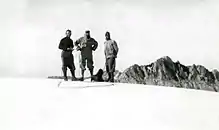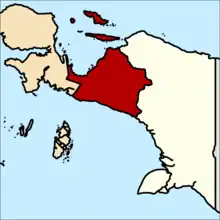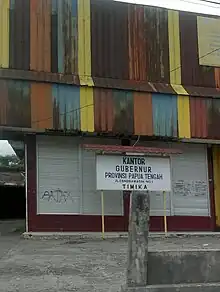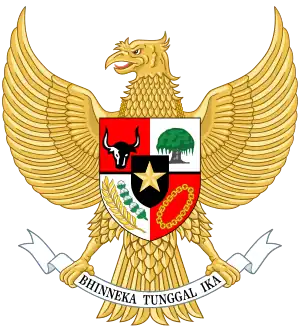Central Papua
Central Papua, officially the Central Papua Province (Indonesian: Provinsi Papua Tengah) is an Indonesian province located in the central region of Western New Guinea.[6][7] It was formally established on 11 November 2022 from the former eight western regencies of the province of Papua. It covers an area of 61,072.92 km2 and had an officially estimated population of 1,430,951 in mid 2022.[3] It is bordered by the Indonesian provinces of West Papua to the west, province of Papua to the north, and by Highland Papua and South Papua to the east. The designated administrative capital is located in Nabire Regency.
Central Papua
Papua Tengah | |
|---|---|
| Province of Central Papua | |
 Coat of arms | |
| Motto(s): Gerbang Cenderawasih (Gate of the Cenderawasih) The motto also applies as acronym for: "Gerakan Pembangunan yang Cepat, Nasionalis, Damai, Sejahtera, Wibawa dan Kasih" ("Action for Development that are Rapid, Nationalist, Peaceful, Prosperous, Authoritative and Loving") | |
 | |
OpenStreetMap | |
| Coordinates: 4°S 136°E | |
| Capital | Nabire Regency |
| Largest city | Timika |
| Government | |
| • Body | Central Papua Provincial Government |
| • Acting Governor | Ribka Haluk[1] |
| • Vice Governor | Vacant |
| Area | |
| • Total | 61,072.92 km2 (23,580.39 sq mi) |
| Highest elevation | 4,884 m (16,024 ft) |
| Population (mid 2022 estimate)[3] | |
| • Total | 1,430,951 |
| • Density | 23/km2 (61/sq mi) |
| Languages | |
| • Official language | Indonesian |
| • Native languages of Central Papua[4] | Auye, Damal, Ekari, Kamoro, Keuw, Kuri, Lani, Moni, Nduga, Wano, Wolani, Yaur, Yeresiam, and others |
| • Also spoken | Javanese, Papuan Malay, and others |
| Demographics | |
| • Religions | Christianity 87,74% –Protestantism 68,59% –Catholicism 19,01% Islam 12,26% Hinduism 0,07% Buddhism 0,03% Other 0,04%[5] |
| • Ethnic groups[4] | Amung, Damal, Ekari, Kamoro, Lani, Moni, Wolani, Yaur (native), Javanese (migrant), and others |
| Time zone | UTC+9 (Indonesia Eastern Time) |
Central Papua are bordered by seas in the north and south. Nabire is situated in the northern part of Central Papua, Indonesia. This lowland area is directly adjacent to the Teluk Cenderawasih National Park and boasts immense potential for marine tourism including coral reefs, white sandy islands, and whale sharks in their natural habitat. The southern part of Central Papua is mostly swampy terrain and the location of port of Amamapare and Timika, the largest town in this province. The central region of Central Papua is dominated by the Jayawijaya Mountains, which encompasses the snow-capped Puncak Jaya, the highest peak in Indonesia. This mountain range is also home to the Grasberg gold mine, operated by Freeport Indonesia.
The provincial border roughly follows the cultural region of Mee Pago and parts of Saireri.[8]
History
Tidore Sultanate
Since the 18th century, the western region of Mimika has been the furthest reach of the Tidore Sultanate's "Uli Siwa" influence on the south-west coast of Papua Island. The region was influenced primarily by three major groups, the Koiwai, Kamoro and Asmat. The trade relations for slaves, ironwares, clothes and body ornaments that were established exerted a great deal of influence on the local population with the use of titles of Moluccan origin (raja, major, kapitan and orang tua) as well as the Islamic culture of the people such as the use of turbaned hats and the custom of not eating pork until the 1950s.[9]
The trading centre of the region is Kipia, led by a leader named Naowa, who received the title of king from Lamora, Namatota (Koiwai) King. Kipia led a confederation of Kamoro villages called Tarya We, along with Poraoka, Maparpe, Wumuka, Umar and Aindua. They co-operated because the region lacked sago and intimidated the more fertile region to the east with canoes and minaki (firearms) received from trade. Meanwhile, in the east there was a major war called the Tipuka War where Tipuka village was destroyed by Koperapoka assisted by a coalition of Mware, Pigapu, Hiripau and Miyoko which was thought to be revenge for Tipuka kidnapping people for trade.[10] This trade relationship and influence from the Moluccas gradually disappeared with the strengthening of Dutch colonialism, and the influx of Catholic missionaries and Chinese traders.[9][10]
Dutch East Indies
_bij_de_Ekari_aan_de_Wissel-meren%252C_KITLV_113778.tiff.jpg.webp)
The interior of Central Papua is inhabited by tribes such as Mee (Ekari) and Moni, who live traditionally by clearing fields and cultivating tubers, raising pigs, fishing, and engaging in feasting. They also use the mege currency made from shells. These indigenous communities were first discovered by the outside world, during the 1930s when a pilot named Frits Wissel flew over the area and came across three large lakes where the Mee tribe resided. The lakes were named Paniai, Tigi, and Tage, and the Dutch referred to the region as Wisselmeeren (Wissel lakes). However, after the colonial era, the name Paniai became more widely used than Wisselmeeren.[11]
During the Round Table Conference on 27 December 1949. The Dutch East Indies government issued a proclamation stating that the territory of Papua controlled by the Dutch East Indies would be under the jurisdiction of a gubernemen called the New Guinea gubernemen. Later in 1952 New Guinea was designated as an overseas province of the Netherlands.[12] Dutch New Guinea was officially divided into four Afdeling on 10 May 1952. The district of Central New Guinea was one of the four afdelings and included Wisselmeren as an onderafdeling. However, unlike the other districts, the Central New Guinea Afdeling did not have a capital city. The New Guinea Government underwent further reorganisation in 1954 and the Central New Guinea Afdeling was temporarily placed directly under the supervision of the Resident of Geelvinkbaai (now Cenderawasih Bay).[12]
Entry of PT Freeport Indonesia

In 1936, the Carstensz expedition, led by Anton Colijn from the Netherlands, conquered Puncak Jaya, the highest mountain in Papua. Among the members of the team was a geologist named Jean Jacques Dozy, who discovered large copper deposits in one of the places they passed. This location was later named Ore Mountain or "Ertsberg" and was published. Reports about this site were ultimately forgotten due to World War II. However, in 1963, the Freeport Sulfur Company discovered this valuable report and sent an expedition to confirm the existence of this natural wealth. The team, led by Forbes Wilson, included geologists Delos Flint. They succeeded in discovering enormous potential in the region, leading to the signing of the first contract with the Government of Indonesia under President Suharto, who had just passed Law No. 1 of 1967 concerning Foreign Investment. Forbes Wilson later became the President of Freeport Indonesia. In 1970, the mine was opened, and the Amungme people were relocated to another area. Apart from opening a mine, Freeport also built supporting infrastructure, including Amamapare Port in the Kamoro Tribe area and a settlement called Kuala Kencana in 1995. The company then opened a new mine, the Grasberg mine in Tembagapura, which contains gold and signed the second contract in 1991.[13][14][15]
During the New Order
Efforts to split Papua Province (formerly known as Irian Jaya Province) have been made since the reign of Governor Busiri Suryowinoto. At that time, President Soeharto encouraged the division of Irian Jaya Province to increase Irian Jaya's representation in the central legislature and to facilitate development in the region.[16] The idea of expansion was also put forward at a seminar on "Local Government Development" in 1982.[17]
Before his death in early August 1982, Busiri put forward three different proposals for the division of the province, which were considered by Kompas journalist Korano Nicolash LMS as the first concept that "contained a comprehensive and detailed division of Irja into three provinces". One of Busiri's proposals was to divide Irian Jaya into three provinces, namely East Irian Jaya, Central Irian Jaya and West Irian Jaya. The Central Irian Jaya province consisted of the districts of Mapurajaya (Mapurajaya), Nabire (Nabire), Enarotali (Enarotali), Mulia (Mulia), Yapen-Waropen (Serui), and Teluk Cenderawasih (Biak).[16] Although this expansion proposal was never realised, President Soeharto approved the division of Irian Jaya into three assistant governorates in 1984.[18]
Expansion in 1999 and 2003

After several years of delay, President B.J. Habibie approved the division of Irian Jaya Province. The province of Irian Jaya was divided into the provinces of Irian Jaya, West Irian Jaya, and Central Irian Jaya through Law Number 45 of 1999 which was enacted on 4 October 1999.[19] Former Assistant Governor of Region II Herman Monim was then inaugurated as the first Governor of Central Irian Jaya on 12 October 1999.[20] However, the division of Irian Jaya Province was opposed by the Irian Jaya DPRD and the DPRD unilaterally cancelled the division four days later. The central government recognised the validity of the decision issued by the Irian Jaya DPRD and the law was withdrawn.[17]
After Irian Jaya was renamed Papua in 2000, demands for the division of Papua province resurfaced. On 23 August 2003, Andreas Anggaibak (Chairman of the Mimika DPRD), Jacobus Muyapa (Chairman of the Paniai DPRD), and Philip Wona (Regent of Yapen Waropen) declared the formation of Central Papua province. As a result of the declaration, the community in the Central Papua region was polarised into two groups, those who supported and those who rejected the division of Central Papua province. The two groups fought and held each other hostage for about a week until finally the central government issued a decision to postpone the division of the province on 28 August. The two parties finally decided to reconcile the day after the decision was issued by the central government. The fighting left five people dead and dozens injured.[19]
Regency expansion
After independence, the current Central Papua region, was administered under Paniai Regency and Fakfak Regency. In 1966, the capital of Paniai was moved from Enarotali in the interior to Nabire on the coast because it was easily accessible by sea transportation, making it strategically important as a gateway to other inland areas. Then, according to Government Regulation Number 52 of 1996, Paniai Regency with Nabire as its capital was renamed Nabire Regency, followed by the establishment of a new Paniai Regency with Enarotali as its capital and Puncak Jaya Regency with Mulia as its capital. Furthermore, the further expansion was enacted in Law Number 45 of 1999, which also resulted in the splitting of Mimika Regency with Timika as its capital from Fakfak Regency.[21][22][23]
After the enactment of the Law on Regional Autonomy, proposals for the formation of new regions began to emerge so that the number of regencies and cities increased rapidly. In 2008, the Central Papua Region itself expanded from 4 regencies to 8. The eastern Paniai Regency was divided into Intan Jaya Regency, the Paniai area around Lake Tigi was divided into Deiyai Regency, the southern side of Nabire Regency was separated into a regency called Dogiyai, and finally the western part of Puncak Jaya was divided into Puncak Regency.[24][25][26][27]
Capital Debate

Regents from 7 districts in Papua signed support for the division of Central Papua in a letter dated 1 November 2019.[28] In the discussion, Mimika and Puncak districts chose Timika to be the capital, while six districts such as Nabire, Dogiyai, Deiyai, Paniai, Intan Jaya, Puncak Jaya wanted the capital in Nabire Regency. The difference of opinion is because Mimika Regency facilities are considered more feasible to become the capital of Central Papua Province, on the other hand, Nabire is more easily accessible by road by several other districts.[29] Finally, the working committee of the DOB Bill has determined Nabire Regency as the capital of Central Papua followed by the ratification of Central Papua as a new province at the DPR plenary meeting on 30 June 2022.[30]
After the approval of the bill for the creation of the province on 30 June 2022,[31] controversy regarding the capital of the new province resulted in mass demonstrations in Timika. Residents of the town argued that the provincial capital should be in Timika instead of Nabire, due to Timika's contribution to the province's economy through the presence of Freeport-McMoRan in their regency.[32] Protesters also argued that the last 20 years of the effort by locals to support the creation of Central Papua province was always with Timika as capital and not Nabire.[32][33] The protesters also threatened to close the Freeport mine by force if their demand to be the capital of the new province was not heard.[32][34] However, figures from Nabire further argued that Nabire is a more suitable capital because it is free from intervention from the mining company on its development and also that Nabire has a higher percentage of native Papuans compared to Timika.[35][36] Furthermore, six regencies of eight in the region, Nabire, Dogiyai, Deiyai, Paniai, Intan Jaya, and Puncak Jaya, preferred Nabire as capital because it has easier road access.[37] Social conflict between residents of Nabire and Timika regarding the position of the new provincial capital was described by the Rev. Dora Balubun, representative from GKI Papua regional synod, as a dangerous side effect of the creation of the new province.[38][33]

On 29 July 2022, Indonesian President Joko Widodo passed Law Number 15 of Year 2022 concerning the Establishment of Central Papua Province as the basis for the establishment of the province.[39] The Wate Tribe community fully supports the location of the capital in Nabire with the use of an additional 300 hectares of land located in Karadiri II Village, Wanggar District, Nabire Regency to become the central government facility (Praspem) of Central Papua Province.[40] To support the new provincial capital, the Central Papua Government also plans to build a new airport in Wanggar.[41] This airport project has actually been built from 2019 to 2021, but was not completed and abandoned due to budget shortages.[42]
Demographics
Ethnic groups
Nabire is inhabited by coastal tribes belonging to the Saireri customary territory, including Yaur, Wate, Mora, Umari, Goa, and Yerisiam as well as the tribes in the mountainous areas that are included in the Mee Pago customary territory, namely Moi, Mee, and Auye (Napan).[43] Located in central part of the province is region around Paniai Lakes inhabited by, other than the aforementioned, Moni and Wolani. Meanwhile, to the east lie the Jayawijaya Mountains, which are inhabited by Amungme, Damalme, Wano, alongside Dani, Lani, and Nduga (Dauwa) which can also be found in the neighboring province of Highland Papua.[44][45] While the southern part of Central Papua is Mimika Regency in the form of swamp land and is inhabited by Kamoro and Sempan.[46]
Religion
Religion in Central Papua (2022)
Politics
Administrative divisions
The area now constituting Central Papua was originally composed of four regencies - Mimika, Nabire, Paniai and Puncak Jaya. Two new regencies were created on 4 January 2008 - Dogiyai from part of Nabire Regency, and Puncak from part of Puncak Jaya Regency. Two further regencies were created on 29 October 2008 - Deiyai and Intan Jaya, both from parts of Paniai Regency. The new province comprises eight regencies (and no administrative cities), listed below with their areas and their populations at the 2010[47] and 2020[48] Censuses and according to the official estimates as at mid 2022.[3] The table also includes the regency capitals and a list of the districts (kecamatan) within each regency.
| Kode Wilayah |
Name of Regency |
Capital | List of Districts |
Area in km2 |
Pop'n Census 2010 |
Pop'n Census 2020 |
Pop'n Estimate mid 2022 |
HDI (2020) |
|---|---|---|---|---|---|---|---|---|
| 94.01 | Nabire | Dipa, Makimi, Menou, Moora, Nabire, Nabire Barat, Napan, Siriwo, Teluk Kimi, Teluk Umar, Uwapa, Wanggar, Wapoga, Yaro, Yaur | 11,806.09 | 129,893 | 169,136 | 173,043 | 0.688 (Medium) | |
| 94.02 | Mulia | Dagai, Dokome, Fawi, Gubume, Gurage, Ilamburawi, Ilu, Irimuli, Kalome, Kiyage, Lumo, Mewoluk, Molanikime, Muara, Mulia, Nioga, Nume, Pagaleme, Taganombak, Tingginambut, Torere, Waegi, Wanwi, Yambi, Yamo, Yamoneri | 5,986.19 | 101,148 | 224,527 | 231,499 | 0.484 (Low) | |
| 94.03 | Enarotali | Aradide, Aweida, Baya Biru, Bibida, Bogabaida, Deiyai Miyo, Dogomo, Dumadama, Ekadide, Kebo, Muye, Nakama, Paniai Barat, Paniai Timur (Enarotali), Pugo Dagi, Siriwo, Teluk Deya, Topiyai, Wegee Bino, Wegee Muka, Yagai, Yatamo, Youtadi | 5,306.87 | 153,432 | 220,410 | 227,254 | 0.563 (Medium) | |
| 94.04 | Timika | Agimuga, Alama, Amar, Hoya, Iwaka, Jila, Jita, Kuala Kencana, Kwamki Narama, Mimika Barat, Mimika Barat Jauh, Mimika Barat Tengah, Mimika Baru (Timika), Mimika Tengah, Mimika Timur, Mimika Timur Jauh, Tembagapura, Wania | 18,298.95 | 182,001 | 311,969 | 321,657 | 0.742 (High) | |
| 94.05 | Ilaga | Agandugume, Amungkalpia, Beoga, Beoga Barat, Beoga Timur, Bina, Dervos, Doufo, Erelmakawia, Gome, Gome Utara, Ilaga, Ilaga Utara, Kembru, Lambewi, Mabugi, Mage'abume, Ogamanim, Omukia, Oneri, Pogoma, Sinak, Sinak Barat, Wangbe, Yugumuak | 7,701.03 | 93,218 | 114,741 | 116,279 | 0.430 (Low) | |
| 94.06 | Kigamani | Dogiyai, Kamu (Kigimani), Kamu Selatan, Kamu Timur, Kamu Utara, Mapia, Mapia Barat, Mapia Tengah, Piyaiye, Sukikai Selatan | 3,792.93 | 84,230 | 116,206 | 119,815 | 0.548 (Low) | |
| 94.07 | Sugapa | Agisiga, Biandoga, Hitadipa, Homeyo, Sugapa, Tomosiga, Ugimba, Wandai | 5,334.45 | 40,490 | 135,043 | 139,236 | 0.478 (Low) | |
| 94.08 | Waghete | Bowobado, Kapiraya, Tigi (Waghete), Tigi Barat, Tigi Timur | 2,846.41 | 62,119 | 99,091 | 102,168 | 0.495 (Low) | |
| Totals | 61,072.92 | 846,531 | 1,391,123 | 1,430,951 | ||||
References
- Subagyo, Triono (2022-11-11). "Mendagri lantik tiga pj gubernur DOB Papua". ANTARA News Lampung (in Indonesian). Retrieved 2022-11-11.
- Setyaningrum, Puspasari (2022-07-02). "Profil Provinsi Papua Tengah". KOMPAS.com. Retrieved 2022-09-11.
- Badan Pusat Statistik, Jakarta, 2023, Provinsi Papua Tengah Dalam Angka 2023 (Katalog-BPS 1102001.94)
- "Mee Pago" (in Indonesian). Jakarta: Badan Penghubung Daerah Provinsi Papua, Republik Indonesia [Regional Liaison Agency of Papua, Republic of Indonesia]. July 2022. Archived from the original on June 9, 2020.
- "Visualisasi Data Kependudukan - Kementerian Dalam Negeri 2022" (Visual). www.dukcapil.kemendagri.go.id (in Indonesian). Retrieved 31 July 2022.
- Santoso, Bangun; Ardiansyah, Novian (2022-06-30). "DPR Sahkan RUU DOB, Papua Kini Punya 3 Provinsi Baru: Papua Selatan, Papua Tengah Dan Papua Pegunungan". suara.com (in Indonesian). Retrieved 2022-07-01.
- Utama, Felldy (2022-06-30). "Usai RUU DOB Papua Disahkan, Ini Perintah Mendagri Buat Bupati Papua Selatan : Okezone Nasional". Nasional Okezone (in Indonesian). iNews. Jakarta: Okezone. Retrieved 2022-07-01.
- Setyaningrum, Puspasari, ed. (2022-07-02). "Profil Provinsi Papua Tengah Halaman all". KOMPAS.com (in Indonesian). Kompas Cyber Media. Retrieved 2022-07-03.
- Pouwer, Jan (2010). Gender, ritual and social formation in West Papua : a configurational analysis comparing Kamoro and Asmat. Leiden: KITLV Press. p. 119. ISBN 90-04-25372-6. OCLC 808384659.
- Harple, Todd S. "Controlling the Dragon: An ethno-historical analysis of social engagement among the Kamoro of South-West New Guinea (Indonesian Papua/Irian Jaya)". openresearch-repository.anu.edu.au. doi:10.25911/5d7a29e964c71. Archived from the original on 2022-06-13. Retrieved 2022-06-13.
- Putri, Amurwani (2012). "Tradisi Prasejarah Berlanjut pada Masyarakat Mee di Kawasan Danau Tigi, Kabupaten Deiyai". PAPUA: Jurnal Penelitian Arkeologi Papua. Balai Arkeologi Papua - Kementerian Pendidikan dan Kebudayaan Indonesia. 4 (2). Archived from the original on 2022-07-02. Retrieved 2022-07-02.
- Renwarin, Herman; Pattiara, John (1984). Sejarah Sosial Daerah Irian Jaya: dari Hollandia ke Kotabaru (1910-1963) (PDF). Direktorat Sejarah dan Nilai Tradisional. pp. 69–74. Archived (PDF) from the original on 2022-07-04. Retrieved 2022-06-30.
- "Sejarah Kami : Latar Belakang Sejarah PTFI". ptfi.co.id. PT. Freeport Indonesia. Archived from the original on 2022-08-11. Retrieved 2022-07-15.
- Paramma, Paulus R.T. (2013). "Dampak Keberadaan PT.Freeport lndonesia Terhadap Tingkat Sosial Ekonomi Masyarakat Suku Amungme Dan Suku Kamoro di Kabupaten". Jurnal JENDELA - Universitas Sains dan Teknologi Jayapura. 1 (1). Archived from the original on 2022-07-15. Retrieved 2022-07-15.
- "Forbes Kingsbury Wilson - 2005 Inductee from Mining's Past". Mining Foundation of the Southwest. Archived from the original on 2022-07-15. Retrieved 2022-07-15.
- Nicolash LMS, Korano (28 March 1994). "Tiga Alternatif Pemekaran Irian Jaya Versi Busiri". Kompas. Jakarta. Archived from the original on 2023-01-24. Retrieved 30 June 2022.
- Romli, Lili (2006). "Pro-Kontra Pemekaran Papua: Sebuah Pelajaran Bagi Pemerintah Pusat". Jurnal Penelitian Politik. 3 (1): 27. Archived from the original on 2020-10-31. Retrieved 2022-06-30.
- Bill (16 January 1984). "Irja dibagi menjadi 3 wilayah pembantu gubernur". Kompas. p. 8. Archived from the original on 2021-06-27. Retrieved 10 June 2021.
- Levi, Cunding (1 September 2003). "Pemekaran yang Menyulut Perang". Tempo.co. Archived from the original on 2021-01-11. Retrieved 30 June 2022.
- "Dilantik, Gubernur Irja dan Maluku Utara". Kompas. 1999-10-13. Archived from the original on 2023-01-24. Retrieved 2022-06-30.
- "PERATURAN PEMERINTAH REPUBLIK INDONESIA NOMOR 52 TAHUN 1996 TENTANG PEMBENTUKAN KABUPATEN PUNCAK JAYA, KABUPATEN PANIAI PERUBAHAN NAMA DAN PEMINDAHAN IBUKOTA KABUPATEN DAERAH TINGKAT II PANIAI DI WILAYAH PROPINSI DAERAH TINGKAT I IRIAN JAYA" (PDF). Archived (PDF) from the original on 2022-07-02. Retrieved 2022-07-02.
- "Undang-undang (UU) No. 45 Tahun 1999 Pembentukan Propinsi Irian Jaya Tengah, Propinsi Irian Jaya Barat, Kabupaten Paniai, Kabupaten Mimika, Kabupaten Puncak Jaya, Dan Kota Sorong". Archived from the original on 2022-07-02. Retrieved 2022-07-02.
- "Sejarah Singkat Kabupaten Nabire". nabirekab.go.id. Pemerintah Kabupaten Nabire. Archived from the original on 2022-09-11. Retrieved 2022-09-08.
- "Undang-undang (UU) No. 54 Tahun 2008 Tentang Pembentukan Kabupaten Intan Jaya di Provinsi Papua". Archived from the original on 2022-07-02. Retrieved 2022-07-02.
- "Undang-undang (UU) No. 8 Tahun 2008 Tentang Pembentukan Kabupaten Dogiyai Di Provinsi Papua". Archived from the original on 2022-07-02. Retrieved 2022-07-02.
- "Undang-undang (UU) No. 7 Tahun 2008 Tentang Pembentukan Kabupaten Puncak Di Provinsi Papua". Archived from the original on 2022-07-02. Retrieved 2022-07-02.
- "Undang-undang (UU) No. 55 Tahun 2008 Tentang Pembentukan Kabupaten Deiyai di Provinsi Papua". Archived from the original on 2022-07-02. Retrieved 2022-07-02.
- "7 Kepala Daerah Inginkan Papua Tengah". kumparan.com. Archived from the original on 2022-06-30. Retrieved 2022-06-30.
- ""Ibarat Mau Berburu Babi Hutan, Dapat Tikus Tanah pun Harus Disyukuri"". Cepos Online (in Indonesian). 2022-06-30. Archived from the original on 2022-07-03. Retrieved 2022-07-02.
- ""Ibarat Mau Berburu Babi Hutan, Dapat Tikus Tanah pun Harus Disyukuri"". Cepos Online (in Indonesian). 2022-06-30. Archived from the original on 2022-07-03. Retrieved 2022-07-02.
- Sutrisno, Eri (2022-07-15). Nuraini, Ratna; Sari, Elvira Inda (eds.). "Indonesia.go.id - Inilah Tiga Provinsi Baru di Papua". indonesia.go.id (in Indonesian). Archived from the original on 30 September 2022. Retrieved 2022-09-26.
- Aditra, Irsul Panca (2022-06-30). Pratiwi, Priska Sari (ed.). "Massa Demo di Gedung DPRD, Tuntut Timika Jadi Ibu Kota Provinsi Papua Tengah". KOMPAS.com (in Indonesian). Timika: Kompas Cyber Media. Retrieved 2022-07-06.
- "DPR sahkan tiga RUU provinsi baru Papua, tapi 'perpecahan masyarakat adat sudah terjadi'". BBC News Indonesia (in Indonesian). Retrieved 2022-07-06.
- Winardi, Ariandono Dijan (5 July 2022). "Permasalahan yang Mengiringi Pengesahan Pemekaran Provinsi Papua Harus Segera Dibereskan". VOI - Waktunya Merevolusi Pemberitaan (in Indonesian). Retrieved 2022-07-06.
- Rejang, Kristin (2022-07-05). "Tokoh Masyarakat: Ini Soal Pemerataan Pembangunan, Ibu Kota PPT Tidak ada Intervensi Freeport". seputarpapua.com (in Indonesian). Timika: seputarpapua. Retrieved 2022-07-06.
- Makawaru (2022-06-29). "Mesak Magai Sebut Nabire Wajar jadi Ibukota Papua Tengah". Papua Inside (in Indonesian). Retrieved 2022-07-06.
- ""Ibarat Mau Berburu Babi Hutan, Dapat Tikus Tanah pun Harus Disyukuri"". Cepos Online (in Indonesian). 2022-06-30. Retrieved 2022-07-02.
- "Timika dan Nabire Saling Rebut Ibukota Provinsi Papua Tengah". Koreri Trans Media (in Indonesian). 2022-06-25. Retrieved 2022-07-06.
- Erwanti, Marlinda Oktavia (2022-07-29). "Jokowi Teken UU Pembentukan 3 Provinsi Baru Papua". detikcom. Archived from the original on 2022-07-29. Retrieved 2022-07-30.
- Saudila, Arnol (10 February 2023). "Kemendagri RI Menuntaskan Lahan Pusat Pemerintahan Propinsi Papua Tengah". RRI.co.id (in Indonesian). Retrieved 8 May 2023.
- Saudila, Arnol (2023-05-11). "Pemprov Papua Tengah Merencanakan Pembangunan Bandara Wanggar Nabire". rri.co.id. Radio Republik Indonesia. Retrieved 2023-05-13.
- Bisay, Jean; Munandar, Aris (2022-04-22). "Proyek Bandara Wanggar di Nabire terancam mangkrak". jubi.id.
- You, Emanuel (2022-07-21). "Menyikapi 6 Suku Pesisir dan Kepulauan Mencari Identitas Adat Mereka di Nabire". papuaposnabire.com (in Indonesian). Retrieved 2022-07-21.
- "PROFIL WILAYAH ADAT MEE PAGO". papua.go.id (in Indonesian). Pemerintah Provinsi Papua. Archived from the original on 2022-07-03.
- "Pemerintah Provinsi Papua". www.papua.go.id. Retrieved 2021-02-16.
- "Kokonao, Keindahan Alam Papua yang Terlupakan". travel.detik.com (in Indonesian). 2012-03-01. Retrieved 2022-07-03.
- Biro Pusat Statistik, Jakarta, 2011.
- Badan Pusat Statistik, Jakarta, 2021.
